‘Spirit of giving back’ shines at awards gala
Heinz Scherle [DMD/76] received the 2024 Alumni of Distinction Award from the UM Dental Alumni Association at a gala in September.
Scherle is an instructor at the UM dental college, former president of the Manitoba Dental Association and has made extensive contributions to the National Dental Examining Board.
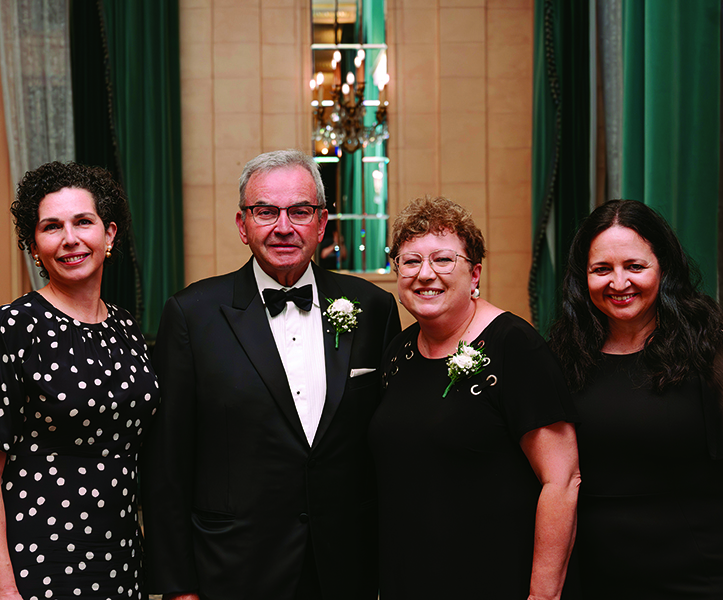
He urged younger dentists to give of themselves. “Consider coming to the school to teach…. You really will get more than what you give.”
Cindy Isaak-Ploegman [Dip.D.Hyg./89, BA/90, M.Ed/03], who has been an educator at the School of Dental Hygiene and the Dr. Gerald Niznick College of Dentistry for more than 25 years, was honoured with the Alumni of Distinction Award from the UM School of Dental Hygiene Alumni Association (UMSDHAA).
Isaak-Ploegman co-founded the UMSDHAA. Her service to the profession has ranged from chairing the complaints committee of the College of Dental Hygienists of Manitoba to editing the periodical of the Manitoba Dental Hygienists Association.
“Cindy embodies the spirit of giving back,” said her colleague Lorraine Glassford [Dip.D.Hyg./88, BA/96].
The gala also paid tribute to the Dentistry Class of 1974.
Network accelerates research on rare diseases in kids
Researchers from UM and the Children’s Hospital Research Institute of Manitoba (CHRIM) have key roles in a national initiative to accelerate research and treatment for rare diseases in children.
RareKids-CAN: Pediatric Rare Disease Clinical Trials and Treatment Network has received $20 million in funding from the Canadian Institutes of Health Research.
The network brings together leaders in several areas, including clinical trials, pharmacology, drug development and data analysis.
“The goal is to provide the essential infrastructure and resources to give children with rare diseases … the opportunity to participate in clinical trials close to home,” said Dr. Lisa Knisley [BN/94], assistant professor of nursing and researcher with CHRIM, who co-leads the network’s knowledge mobilization platform.
Dr. Cheryl Rockman-Greenberg, distinguished professor of pediatrics and child health and researcher with CHRIM, will focus on the regulatory affairs and advocacy aspects of the project.
“There are over 8,000 different rare diseases, and over 50 per cent of those affect children,” she said. “Our ability to diagnose these disorders has increased, but access to new diagnostic techniques and new treatments has not kept pace.”
Acting dean appointed at College of Pharmacy
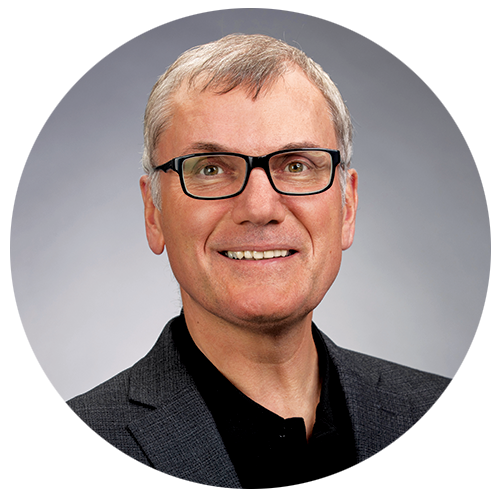 Dr. Lavern Vercaigne [B.Sc.Pharm/91], a 30-year faculty member of the College of Pharmacy, was appointed acting dean of the college in September.
Dr. Lavern Vercaigne [B.Sc.Pharm/91], a 30-year faculty member of the College of Pharmacy, was appointed acting dean of the college in September.
Vercaigne earned his bachelor of science in pharmacy from UM in 1991, followed by a doctor of pharmacy from the University of Toronto in 1995.
He then completed a postdoctoral fellowship in pharmacy and nephrology. His clinical practice and research have focused on the area of chronic kidney disease.
He has taught extensively at UM and provided significant service to external organizations and the pharmacy profession.
Vercaigne has contributed to the College of Pharmacy as the associate dean (academic) since 2010 and through numerous committee roles. He provided extensive leadership during the college’s transition to delivering the current doctor of pharmacy (PharmD) undergraduate program.
Dr. Lalitha Raman-Wilms, former dean of the college, has joined the University of British Columbia as dean of the Faculty of Pharmaceutical Sciences.
Partnership brings physio to First Nations communities
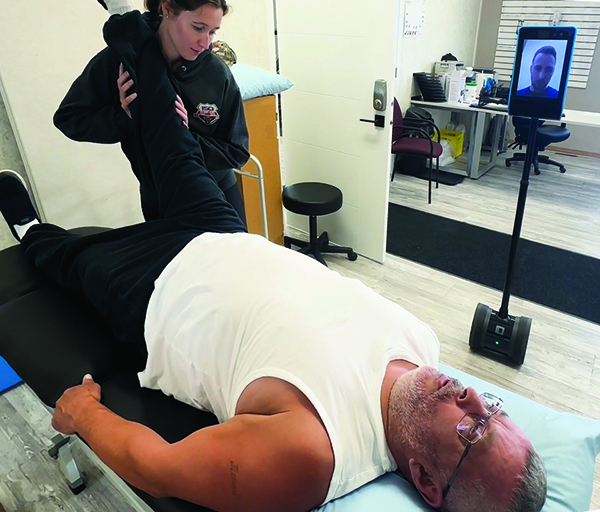
Residents of Lake Manitoba First Nation and Pinaymootang First Nation now have access to physiotherapy and rehabilitation expertise without having to travel.
“Telerehabilitation” refers to the delivery of rehab services from a distance, using technologies such as videoconferencing or telepresence robots.
These services have been introduced in the two Interlake communities through a collaboration among the Interlake-Eastern Regional Health Authority, Winnipeg’s Riverview Health Centre and UM.
Riverview has hired Tim Romanec [MPT/23], a UM-educated physiotherapist, to travel to the First Nations every second week for in-person consultations. Between visits, he works with clients via videoconference, linking a room at Riverview with health centres in each First Nation.
“I operate a remote-controlled camera to make sure I can see the client correctly as I’m treating them remotely,” Romanec said. “There is also a rehabilitation assistant from the community on hand at each First Nation health centre.”
The project expands on telerehabilitation services that the UM College of Rehabilitation Sciences offers through its student-led clinic at Riverview.
Graphic novel addresses homophobia in sport
A new graphic novel based on research by a nursing faculty member looks at gender and sexuality through a Cree lens, with a focus on toxic masculinity and homophobia in sport.
Funded by the Winnipeg Suicide Prevention Network, Between the Pipes was published in September by HighWater Press. It centres on a 13-year-old Indigenous hockey goalie who faces homophobic bullying by his teammates, but finds support in several ways.
 The story was influenced by the lived experiences of 2SLGBTQI+ Manitobans. These were gathered through interviews and focus groups by Dr. Elaine Mordoch [BN/91, MN/96], who has retired and is now an unsalaried associate professor of nursing. Mordoch co-led the project with Two-Spirit Elder Albert McLeod.
The story was influenced by the lived experiences of 2SLGBTQI+ Manitobans. These were gathered through interviews and focus groups by Dr. Elaine Mordoch [BN/91, MN/96], who has retired and is now an unsalaried associate professor of nursing. Mordoch co-led the project with Two-Spirit Elder Albert McLeod.
The research participants “all had stories of trauma and harsh experiences during their youth,” Mordoch said. “These stories were balanced with a strong message of hope for today’s youth.”
Mordoch and McLeod worked with an Ojibwe artist and a Swampy Cree writer to complete the graphic novel. Between the Pipes is aimed at Indigenous youth aged 12 to 15.
College of Nursing unveils Indigenous lounge and mural
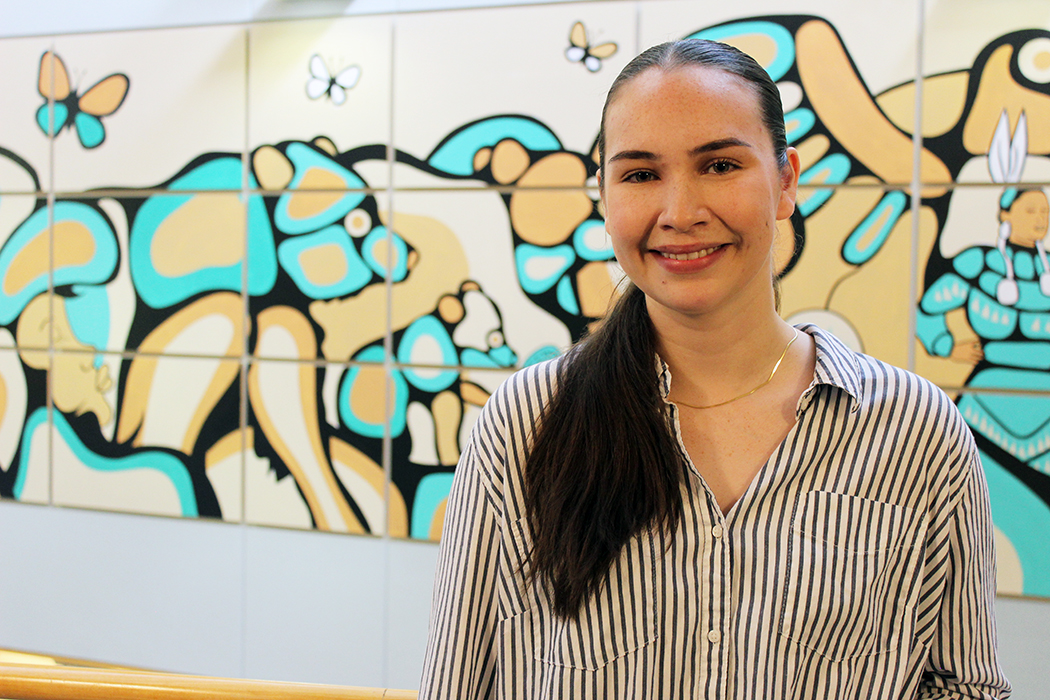
A new lounge for participants in Mahkwa Omushki Kiim: Pathway to Indigenous Nursing Education (PINE) opened in September at the Helen Glass Centre for Nursing.
PINE offers academic, personal and cultural support to help First Nations, Métis and Inuit students prepare for and succeed in the bachelor of nursing program. The lounge gives Indigenous learners a space to study, socialize, smudge and access an outdoor medicine garden.
Student Justice Spence [BN/24] welcomed the gathering place. “This lounge is really valuable,” she said. “This is somewhere I can feel safe and comfortable.”
The Helen Glass Centre also celebrated the creation of a new mural by Anishinaabe artist Blake Angeconeb. It includes imagery of bears and expresses themes of caring, healing and transformation.
Brenda Longclaws [B.Ed./86, M.Ed./00], Knowledge Keeper at the college, said the mural serves as a powerful symbol of cultural awareness and reconciliation.
“It really adds to the beauty of the college, but I think the significance lies in the fact that it is a piece of Indigenous artwork,” she said.
‘Crash course in culture’
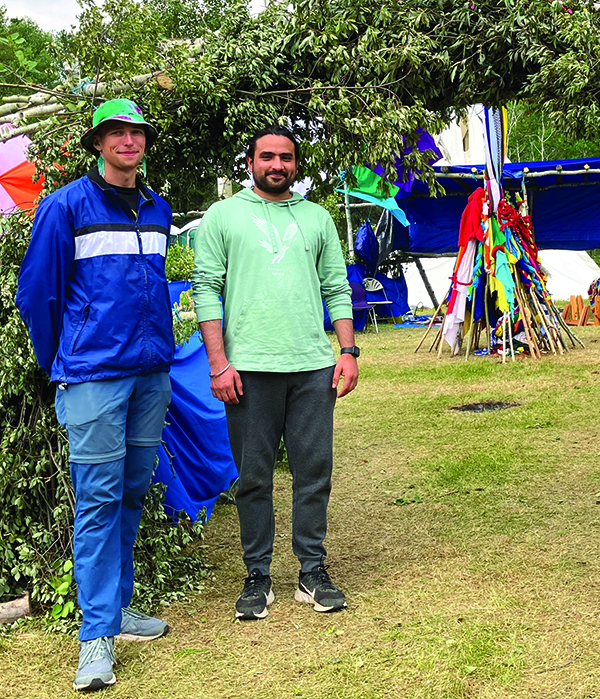
A program through the Office of Interprofessional Collaboration (OIPC) in the Rady Faculty of Health Sciences is deepening students’ cultural understanding of Indigenous communities.
The program enables students to assist with sacred sundance ceremonies. “It’s a powerful way … to learn about community, health and ways of healing,” said Lisa Mendez [BMROT/99, MOT/12], senior instructor in occupational therapy and collaborative health-care practice lead with OIPC.
Knowledge Keeper George Muswaggon described sundances and related activities as a “crash course in culture.” Students help with various tasks, including the construction of an eight-sided lodge for the ceremony.
In 2024, students from nursing, midwifery, pharmacy, physical therapy, occupational therapy, respiratory therapy and medicine took part in sundances in Spruce Woods, Misipawistik Cree Nation, Opaskwayak Cree Nation and Pimicikamak Cree Nation.
Dana Riseling, an occupational therapy student, said the experience opened her mind to using a holistic approach.
“In Western medicine, we tend to focus on the individual. I want to consider how I can incorporate community-level care and advocate for people to receive care within their family and community setting.”
Department celebrates 25 years
The department of biochemistry and medical genetics in the Max Rady College of Medicine recently marked the 25th anniversary of its formation in 1999.
A celebratory breakfast was held during Homecoming 2024.
It featured presentations by former department heads (now professors emeriti) Dr. Patrick Choy, Dr. Jane Evans and Dr. Louise Simard, alongside insights from alumni and current students.
Barbara Triggs-Raine [B.Sc.(Hons.)/83, PhD/87], professor and then-head of the department, said it has made significant strides in personalized medicine and data science. It has launched a genetic counselling program, a clinical training program and a computational biology stream.
Looking toward the future, Triggs-Raine expressed optimism about emerging technologies, particularly gene therapy. “The potential is there to cure many genetic diseases,” she said.
The department has seen significant recent growth, expanding its faculty with seven new hires in the past six years. Forty-five graduate students are now enrolled.
Students lead workshop for Parkinson’s community
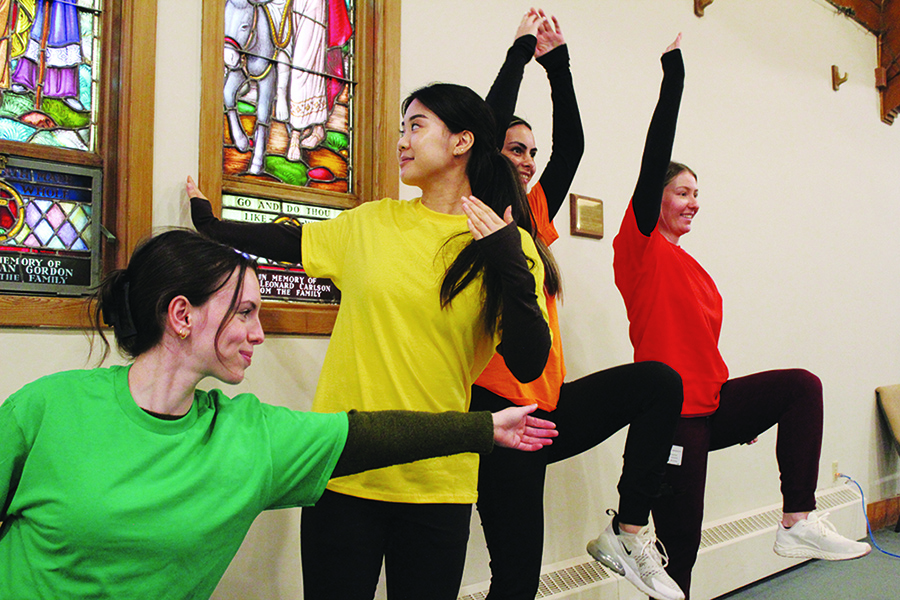
An interprofessional group of students led a workshop last spring for more than 40 people living with Parkinson’s disease.
The event was held in partnership with UTurn Parkinson’s, an organization that meets at a Winnipeg church. About 20 students in rehabilitation sciences, nursing and pharmacy participated as part of fieldwork placements.
Physical therapy students led exercises geared to various levels of difficulty, based on UTurn Parkinson’s colour-coded system. Students wore T-shirts in four different colours, and participants could follow the student wearing the colour that best suited their abilities.
“We know that Parkinson’s has no cure, that it is progressive, and the only thing that will make things better for us – other than our medication – is exercise,” said Tim Hague, founder of UTurn Parkinson’s.
“The students bring the whole analytical side to it, the research – plus a lot of energy and knowledge from their individual specialties.”
Three pharmacy students gave a presentation on medications used for Parkinson’s and how they can interact with over-the-counter drugs.
“It was really eye-opening to see how many questions there were for us at the end,” said student Daria Rempel.
Rotation opens students’ eyes to rural dentistry
“Awesome” is how two fourth-year dental students described participating in the first rural rotation offered at the Dr. Gerald Niznick College of Dentistry in many years.
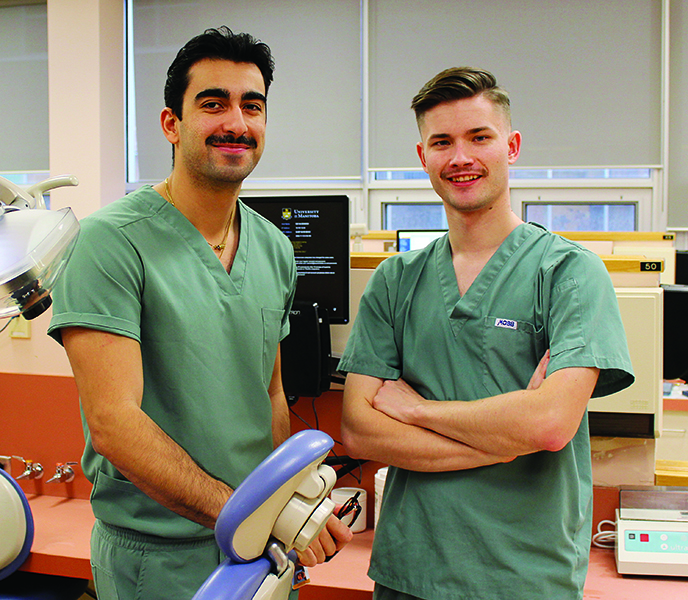
Quinn Boyko and Amirali Paknahad [BA/21] spent a week in the fall immersed in experiential learning at a three-dentist office in Dauphin, Man.
“They did an amazing job of showing us the lifestyle, the hours and the scheduling,” said Paknahad, who is from Toronto.
Boyko, a Winnipegger, learned that rural dentists perform a wide variety of procedures. “In the city … it’s easy just to refer someone to a specialist, but up there, they’re almost super-dentists.”
Paknahad agreed. “In the city, you might see a dentist who doesn’t do extractions or doesn’t do pediatrics, but everyone did everything in Dauphin, including us.”
Four students are doing rural rotations this academic year, and the opportunity is expected to expand, said Dr. Trenna Reeve, associate dean (clinical).
The students who went to Dauphin said they’re now considering rural practice. “It brought to light many of the positives for me, and what I could offer a community,” said Paknahad.
Pharmacy prof receives Brain Canada support
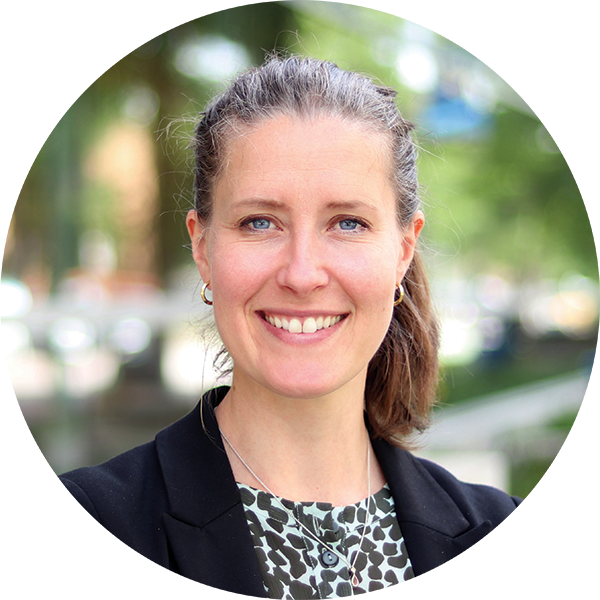 Dr. Kaarina Kowalec [B.Sc. (Hons.)/08, M.Sc./11], assistant professor in the College of Pharmacy, recently received $100,000 from Brain Canada’s Future Leaders in Canadian Brain Research program.
Dr. Kaarina Kowalec [B.Sc. (Hons.)/08, M.Sc./11], assistant professor in the College of Pharmacy, recently received $100,000 from Brain Canada’s Future Leaders in Canadian Brain Research program.
Kowalec is interested in the genetic determinants of disease progression in multiple sclerosis (MS). Her Brain Canada-funded study focuses on brain and cognitive reserve in this disease.
“Reserve” refers to the ability to tolerate age- and disease-related changes to the brain without symptoms. Kowalec is investigating how gene combinations or gene scores associated with aging traits affect cognitive reserve and brain atrophy in MS.
“Understanding the role of genetic factors in cognitive reserve can transform how we predict and treat MS,” she said.
Dr. Robert Beattie [B.Sc.(Hons.)/09] and Dr. Paul Marcogliese, assistant professors of biochemistry and medical genetics, also received $100,000 grants from the Future Leaders program for research on brain disorders.
Dean’s Prize goes to outstanding grad students
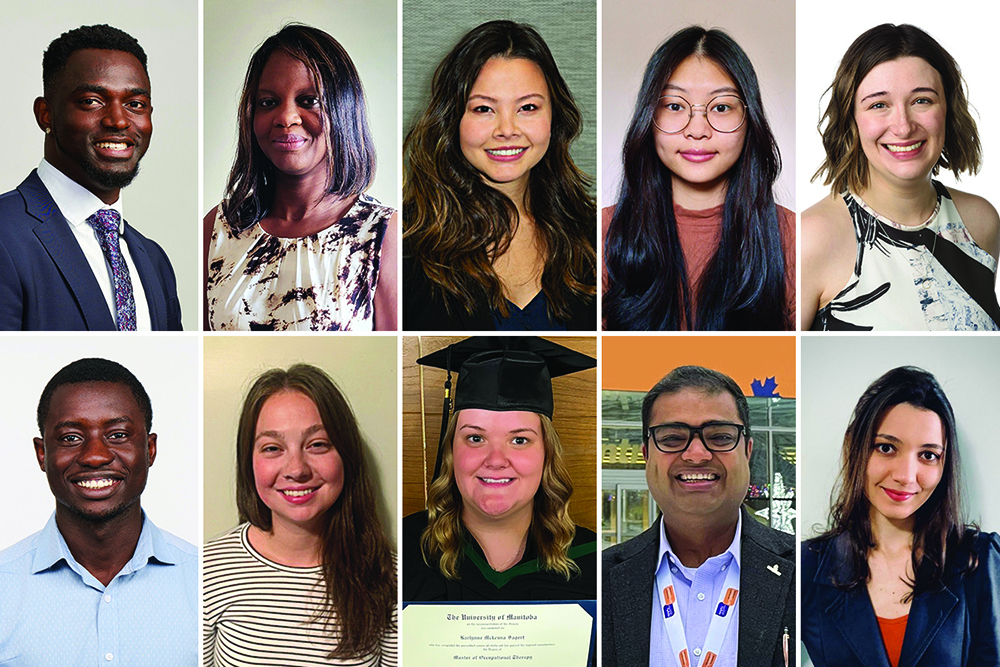
(Bottom row): Olanipekun, Prenovault, Sagert, Sanghai, Schettini
Ten master’s or doctoral students were awarded the Dean of the Rady Faculty of Health Sciences Graduate Student Achievement Prize in 2024. The prize recognizes exceptional academic achievement, notable personal service and leadership.
Pelumi Samuel Akinola [M.Sc./24], who received his master’s in pharmacy, examined the risks of autism spectrum disorder in children after exposure to antiseizure medications during pregnancy.
Eunice Korkor Assem-Erhaze, a nursing PhD student, is researching the transition-to-practice experience of recent nursing grads with learning disabilities.
Meagan Brown, a master’s student in oral and maxillofacial surgery, is studying the use of ultrasound to diagnose pathologic conditions of the temporomandibular joint.
Shelly Lam [B.Sc./22, MPT/24], who received her master of physical therapy, is passionate about advocating for improved accessibility to publicly funded physiotherapy.
Emma Martell, a PhD student in human anatomy and cell science and pathology, is focused on inhibiting the growth of adult and pediatric brain tumours.
Tobi Olanipekun, a master’s student in physiology and pathophysiology, is studying a protein, thioredoxin, as a potential treatment for neurodegenerative conditions.
Nicole Prenovault, a master’s student in nursing, is exploring whether newly graduated nurses are able to thrive in the workplace.
Karlynne Sagert [BA/21, MOT/24], who received her master of occupational therapy, studied current community living compared with past institutions for people with intellectual disabilities.
Nitesh Sanghai, a PhD candidate in pharmacy, is working to develop improved versions of the drug edaravone.
Ana Schettini [M.Dent/24], who received her master’s in prosthodontics, investigated the effects of manufacturing processes on cobalt-chromium dental alloys.
UM team leads $6.9-million clinical trial
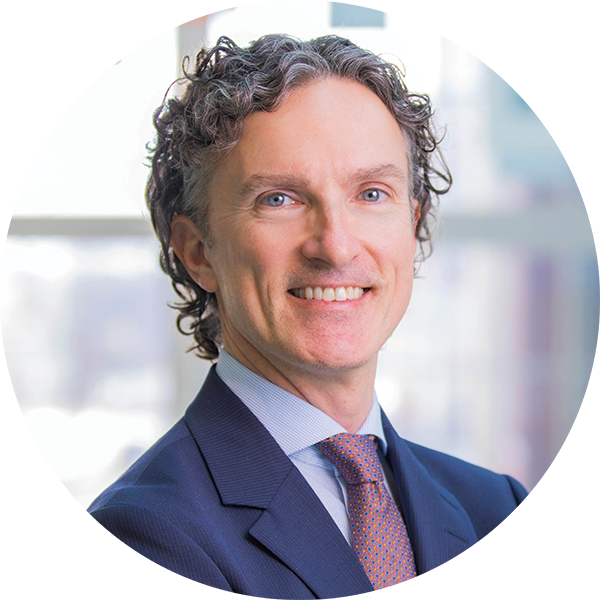
An international, UM-led clinical trial to assess the effects of a steroid drug on patients hospitalized with pneumonia has been awarded $6.9 million by the Canadian Institutes of Health Research (CIHR).
The three-year project, the largest international clinical trial ever led by UM, is co-led by Dr. Ryan Zarychanski [B.Sc./95, B.Sc.(Med.)/00], scientific director of the George & Fay Yee Centre for Healthcare Innovation and professor of internal medicine, and Sylvain Lother [B.Sc./09, B.Sc.(Med.)/13, MD/13, M.Sc./24], assistant professor of internal medicine.
The trial will assess the impact of treating community-acquired pneumonia (CAP) patients with dexamethasone – an inexpensive steroid drug – in addition to antibiotics.
Adult CAP patients on wards – as opposed to intensive care units – at 60 hospitals across Canada, the U.S. and Brazil will be asked to participate in the double-blind study. The CIHR funding will enable the research team to add more sites to the initial 60-site network.
Canada lacks capacity and infrastructure for conducting clinical trials on hospital wards, so this project will have lasting benefits, the scientists said.
“We’re developing Canada’s first post-pandemic, ward-based platform for conducting trials to fight respiratory illnesses,” said Lother.
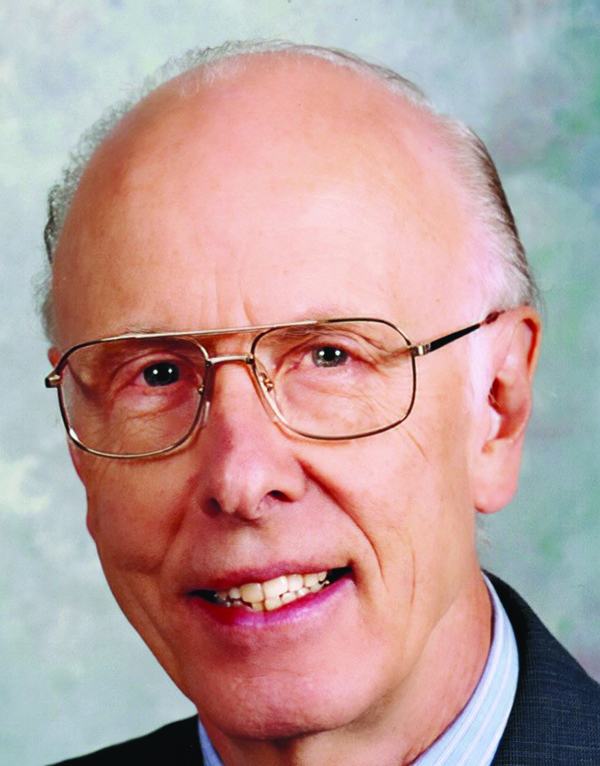 Ken Thorlakson [MD/49], a distinguished surgeon and longtime UM faculty member in surgery, died in January 2024 at the age of 100.
Ken Thorlakson [MD/49], a distinguished surgeon and longtime UM faculty member in surgery, died in January 2024 at the age of 100.
Thorlakson’s connection to UM spanned 80 years. He was a pioneer in gastric bypass surgery and was instrumental in introducing mammography to Manitoba.
He was a fellow of the Royal College of Surgeons of Canada and a Knight of the Icelandic Order of the Falcon. His many other honours included the Order of Canada.
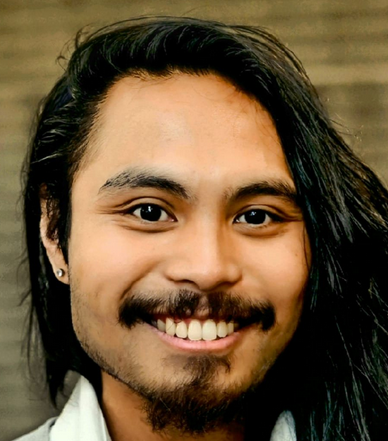 Nolan De Leon [B.Sc./19], an MD/PhD candidate in the Max Rady College of Medicine, represented UM in November at the global Falling Walls Science Summit in Berlin. De Leon had previously won the UM version of the competition.
Nolan De Leon [B.Sc./19], an MD/PhD candidate in the Max Rady College of Medicine, represented UM in November at the global Falling Walls Science Summit in Berlin. De Leon had previously won the UM version of the competition.
The summit is an interdisciplinary forum for scientific breakthroughs. It commemorates the fall of the Berlin Wall and aims to promote dialogue between science and society.
De Leon’s presentation was called Breaking the Wall of Prenatal Diagnostics.
